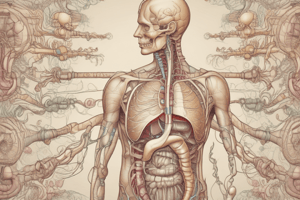Podcast
Questions and Answers
What is the function of the esophagus?
What is the function of the esophagus?
- Connecting the pharynx to the stomach (correct)
- Producing saliva to help break down food
- Storing bile produced by the liver
- Aiding in mechanical digestion of food
Where does the food travel after leaving the stomach?
Where does the food travel after leaving the stomach?
- To the large intestine
- To the small intestine (correct)
- Back to the mouth
- To the liver
Which part of the digestive system produces saliva to aid in breaking down food?
Which part of the digestive system produces saliva to aid in breaking down food?
- Pancreas
- Salivary glands (correct)
- Liver
- Stomach
What is the main function of the mouth in the digestive system?
What is the main function of the mouth in the digestive system?
Which organ is responsible for producing bile and supporting digestion?
Which organ is responsible for producing bile and supporting digestion?
What is the primary function of the stomach in the digestive system?
What is the primary function of the stomach in the digestive system?
Where does the majority of the absorption of nutrients from ingested food take place in the body?
Where does the majority of the absorption of nutrients from ingested food take place in the body?
Which organ's function involves emulsifying large masses of fat in the duodenum?
Which organ's function involves emulsifying large masses of fat in the duodenum?
Which part of the digestive system is responsible for absorbing water and vitamins while converting digested food into waste?
Which part of the digestive system is responsible for absorbing water and vitamins while converting digested food into waste?
Where does mechanical digestion begin in the digestive system?
Where does mechanical digestion begin in the digestive system?
Flashcards are hidden until you start studying
Study Notes
Esophagus and Digestion
- The esophagus functions as a muscular tube that transports food from the mouth to the stomach through peristalsis.
Post-Stomach Journey
- After leaving the stomach, food travels to the small intestine, where digestion and nutrient absorption continue.
Saliva Production
- Saliva is produced by the salivary glands, aiding in the initial breakdown and moisture of food.
Mouth Functionality
- The primary function of the mouth is mechanical digestion through chewing, combined with secretion of saliva for chemical digestion.
Bile Production
- The liver is responsible for producing bile, which is crucial for the digestion of fats.
Stomach Functions
- The main function of the stomach is to mechanically and chemically break down food, producing a semi-liquid mixture called chyme.
Nutrient Absorption
- The majority of nutrient absorption occurs in the small intestine, specifically within its lining via villi and microvilli.
Fat Emulsification
- The gallbladder stores bile produced by the liver, releasing it into the duodenum to emulsify large masses of fat.
Water and Waste Management
- The large intestine absorbs water and vitamins, converting undigested food into waste for excretion.
Mechanical Digestion Initiation
- Mechanical digestion begins in the mouth, where food is masticated, mixed with saliva, and prepared for further digestion in the stomach.
Studying That Suits You
Use AI to generate personalized quizzes and flashcards to suit your learning preferences.



